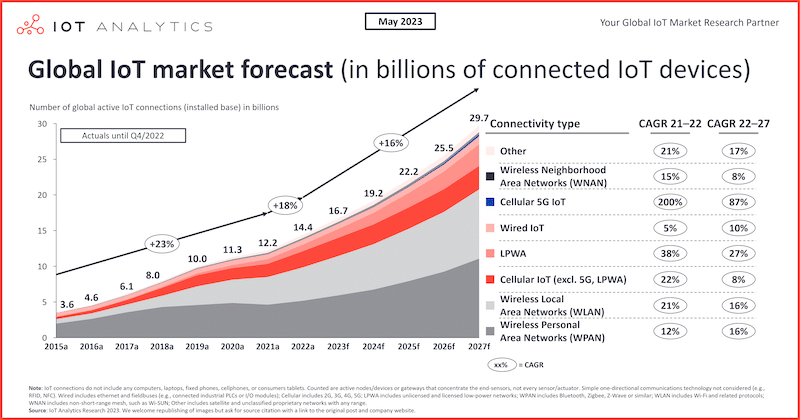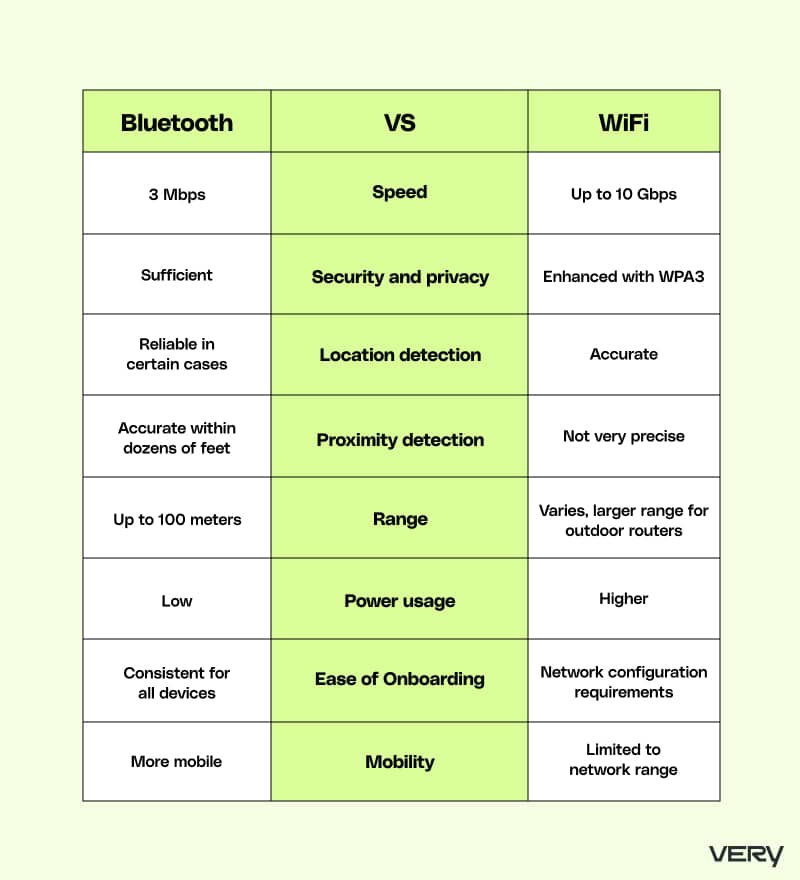BLOG
Bluetooth vs. Wi-Fi for IoT: Which is Better?
Both Bluetooth and WiFi are commonly used for IoT devices, but there are advantages and drawbacks to both choices because they operate in different ways. In this article, we’ll compare the differences between Bluetooth and WiFi as it pertains to IoT.

Bluetooth IoT Devices
Bluetooth is a wireless technology protocol that relies on physical proximity to establish connections between devices without the need for a password. Bluetooth technology operates on radio frequencies in the 2.4 GHz spectrum. While Bluetooth SIG reports that the technology can range can be anywhere from 1 meter to 1 kilometer (3 feet to approximately 0.6 miles) depending on device class and context, it’s commonly understood that Bluetooth works best for short-range situations.
Examples of Bluetooth technology include Apple’s wireless headphones AirPods, as well as many wireless devices such as speakers, computer mice, and keyboards.
Bluetooth IoT Compatibility Requirements
For an IoT device to be compatible with Bluetooth, it must have a microprocessor capable of handling Bluetooth technology, as well as a second device to pair with it. Bluetooth offers two versions commonly used by IoT devices: Bluetooth Classic and Bluetooth Low Energy (BLE), which is designed for devices that need to consume low amounts of power.
Developers often choose Bluetooth over WiFi for IoT devices for several reasons. First, Bluetooth usually requires physical proximity to initiate a signal broadcast, which decreases the potential attack vectors that an improperly secured network would pose. Second, Bluetooth requires much less energy than WiFi, so it works better for low-power IoT devices such as basic sensors.
WiFi IoT Devices
WiFi is a wireless networking technology that uses various bands of radio waves to transmit information between devices. All modern computers and smartphones come with built-in WiFi capability.
WiFi IoT Compatibility Requirements
WiFi usage on an IoT device requires a microchip, which is easily obtainable and cost-effective. However, practical implementation also involves firmware management of the device’s WiFi credentials, as WiFi can be vulnerable to malicious actors.
WiFi is commonly used in large, stationary IoT hubs, although it can also be used in smaller devices. To connect to WiFi, an IoT device needs to be in close proximity to a WiFi access point (i.e. not located far afield).
Bluetooth vs. WiFi for IoT: Feature Comparison
Now that we’ve discussed the basics of both Bluetooth and WiFi, let’s go over how the two technologies stack up in terms of different features.
1. Speed
WiFi has a maximum theoretical speed that is much faster than Bluetooth: nearly 10 Gbps for WiFi , vs. only 3 Mbps for Bluetooth. As a result, Bluetooth is more suitable for transmitting small chunks of data, such as numerical values from IoT sensors, while WiFi excels in transmitting larger data files like videos and photos.
2. Security and privacy
Bluetooth provides sufficient security for most purposes, although it is not intended as a fully secure protocol. However, using WiFi can help if you’re concerned about sensitive data transmission. WiFi can add an additional layer of security by using a security protocol such as WEP, WPA, WPA2, and WPA3 (the latest and preferred version of WPA).
3. Location detection
The right answer here will depend on the accuracy and precision required from your use case. Both WiFi and Bluetooth can provide accurate location information, although Bluetooth may be somewhat more reliable in certain instances.
4. Proximity detection
The proximity data provided by BLE is much more accurate than WiFi, but still not very accurate either. (We’re talking an estimate that’s accurate not within inches, but perhaps within dozens of feet.)
5. Range
Bluetooth typically has a smaller range than WiFi. Class 1 Bluetooth devices are expected to have a maximum range of 100 meters (328 feet), but most consumer Bluetooth devices have a range less than this-often just 10 meters (33 feet). In addition, the range of Bluetooth will depend on the obstacles and the density of the walls between the two devices. WiFi range also varies depending on factors such as frequency, transmission power, antenna type, and environment; WiFi routers located outdoors typically have a much larger range.
6. Power usage
If you use WiFi, you may need to include an additional directly connected power source for your device. Bluetooth was designed to use less power than WiFi, especially with the BLE protocol.
7. Ease of Onboarding
Bluetooth offers the potential for a consistent onboarding process for all devices and situations. WiFi onboarding, however, may require additional steps or customer support to ensure successful integration due to network configuration requirements.
8. Mobility
Despite Bluetooth having a shorter range than WiFi, it’s the more mobile technology since devices can travel remotely and easily reconnect to a hub or gateway when possible. It’s also possible for the gateway to travel remotely, such as in the case of a cell phone with service in an otherwise remote location. WiFi networks are normally limited to the location that the network was created in and have excellent mobility within that range but very limited capacity to extend further.

Bluetooth vs. WiFi for IoT: Which Is Better?
When considering Bluetooth vs. WiFi for IoT, there is no definitive answer. The choice depends on your specific business needs, priorities, and how the device will be used.
Note that technically, it’s not possible to have an IoT device that only uses Bluetooth, since it still requires an intermediary device that will broadcast the data it receives using some network technology e.g. WiFi, cellular.
In general, Bluetooth is better for mobile devices that have limited power requirements. Meanwhile, WiFi is better for larger, more stationary devices that need a direct connection to the Internet.











